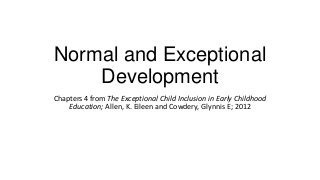Normal and exceptional development and developmental disabilities
•Download as PPTX, PDF•
3 likes•5,093 views
2014sp, EDU 221, CCC, Chapter 4
Report
Share
Report
Share

Recommended
Child and Adolescence DevelopmentFACTORS AFFECTING DEVELOPMENT:PHYSICAL AND SENSORY DISABILITIES;ATTENTION DEF...

FACTORS AFFECTING DEVELOPMENT:PHYSICAL AND SENSORY DISABILITIES;ATTENTION DEF...Supreme Student Government
Recommended
Child and Adolescence DevelopmentFACTORS AFFECTING DEVELOPMENT:PHYSICAL AND SENSORY DISABILITIES;ATTENTION DEF...

FACTORS AFFECTING DEVELOPMENT:PHYSICAL AND SENSORY DISABILITIES;ATTENTION DEF...Supreme Student Government
More Related Content
Viewers also liked
Viewers also liked (17)
special education and Classification of Disabilities

special education and Classification of Disabilities
More from blantoncd
More from blantoncd (20)
Education purpose, organization, governance, and funding

Education purpose, organization, governance, and funding
Recently uploaded
Mehran University Newsletter is a Quarterly Publication from Public Relations OfficeMehran University Newsletter Vol-X, Issue-I, 2024

Mehran University Newsletter Vol-X, Issue-I, 2024Mehran University of Engineering & Technology, Jamshoro
Recently uploaded (20)
Unit-V; Pricing (Pharma Marketing Management).pptx

Unit-V; Pricing (Pharma Marketing Management).pptx
Ecological Succession. ( ECOSYSTEM, B. Pharmacy, 1st Year, Sem-II, Environmen...

Ecological Succession. ( ECOSYSTEM, B. Pharmacy, 1st Year, Sem-II, Environmen...
SECOND SEMESTER TOPIC COVERAGE SY 2023-2024 Trends, Networks, and Critical Th...

SECOND SEMESTER TOPIC COVERAGE SY 2023-2024 Trends, Networks, and Critical Th...
This PowerPoint helps students to consider the concept of infinity.

This PowerPoint helps students to consider the concept of infinity.
Z Score,T Score, Percential Rank and Box Plot Graph

Z Score,T Score, Percential Rank and Box Plot Graph
Presentation by Andreas Schleicher Tackling the School Absenteeism Crisis 30 ...

Presentation by Andreas Schleicher Tackling the School Absenteeism Crisis 30 ...
Normal and exceptional development and developmental disabilities
- 1. Normal and Exceptional Development Chapters 4 from The Exceptional Child Inclusion in Early Childhood Education; Allen, K. Eileen and Cowdery, Glynnis E; 2012
- 2. Who Are “Exceptional” Children? • Children first! • Have some atypical development • As with all children, our goal is to help improve each child’s overall development
- 3. NAEYC Standard 1: Knowledge of how children develop and learn • As professionals, we must know typical development in all of the developmental domains. • What is normal, or typical, development? • What is the predictable pattern of development along the developmental continuum? • What is the importance of the concepts of DAP? Are we knowledgeable of child development? Of individual differences? Of cultural considerations?
- 4. Developmental Sequences • Predictable patterns of development • Not a smooth process; there are times of tremendous development and times of slowing down throughout a child’s developmental years. • Developmental milestones are predictable and universal • Note the developmental descriptions for children from infancy through the primary school years on pp. 83 – 88 in your text.
- 5. Atypical/Exceptional Development • Know your terms • Savants • People-first language • Characteristics of disabilities and delays • Children still have the potential for growth in all developmental domains • Children generally go through the same developmental milestones, just at a different rate • Some impairments “may never interfere with developmental progress”
- 6. Children “At Risk” • Problems are likely to develop; a prospect for healthy development, especially with early intervention • Risk factors may be biological and/or environmental • The more risk factors, the higher the incidence and prospect of longterm disabilities • Risk factors may or may not be chronic
- 7. Risk Factor Examples • Biological • Premature births • Genetic and hereditary disorders • Environmental • • • • Poverty Abuse and neglect Poor living conditions Lack of healthcare
- 8. Resiliency and Vulnerability • Children with resilience factors are better able to bounce back from difficult experiences • Children who are vulnerable are more likely to be impacted negatively by difficult experiences
- 9. Children with Gifts and Talents • While most children have some of the characteristics listed on p. 93 in your text, the children who are gifted and talented exhibit many of the characteristics listed • Children who are gifted and talented are not necessarily ahead of other children their age in all developmental domains • Many gifted and talented children from minority groups or from impoverished circumstances are not likely to be identified • Children who have developmental disabilities may be gifted and talented, but they are less likely to be identified.